Zalman CNPS9900DF CPU Cooler Review

Today we are going to review a very beautiful and stylish cooler from Zalman. No doubt, it will contribute to the holiday spirit, but will it be a good fit for an overclocked processor?
Every holiday season we decorate our homes and streets with multi-color light garlands, put up Christmas trees and other fun décor. However, these are not the only things that could add some color to the holidays. Why not a beautiful processor cooler, which could look absolutely stunning on an open stand or through a clear side panel of the system case? The new Zalman CNPS9900DF will be a perfect cooler for the job. Interested? I am sure you will have no doubts about it once you meet it face to face. And as for its cooling efficiency and noise… Well, let’s not get ahead of ourselves and start from the very beginning.
Technical Specifications and Recommended Pricing
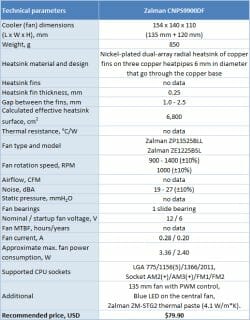
Packaging and Accessories
The cardboard box with Zalman CNPS9900DF is very strict and stylish, with the black color dominating the palette. The front of the box has the model name, of course, and a cut-out window revealing the fan and part of the cooler heatsink:
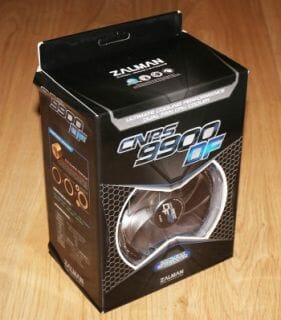
The sides and the back of the box are dedicated to detailed description of the technologies, technical specifications and photographs of the cooler:
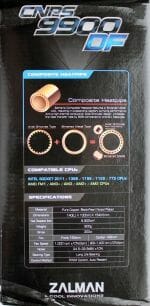
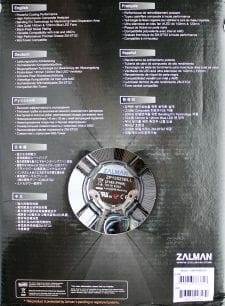
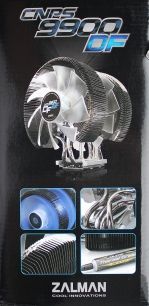
By the way, there is another window in the back of the box. It is of much smaller diameter than the one in the front and reveals only the sticker on the fan motor and a small part of the heatsink.
Inside the cardboard box we find an additional plastic casing, which holds the cooler:
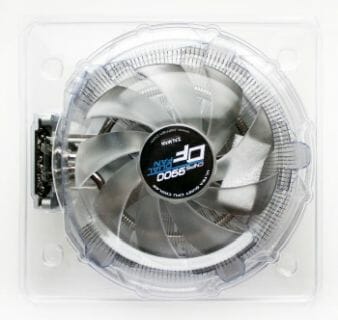
Moreover, there is an additional plastic ring holding the heatsink arrays together. So, it would be fair to say that the packaging of Zalman CNPS9900DF is exceptionally reliable and should protect the cooler perfectly against any possible transportation mishaps.
The accessories bundle is quite typical of the products from this Korean manufacturer and contains everything necessary to successfully install this cooler onto any of the supported platforms:
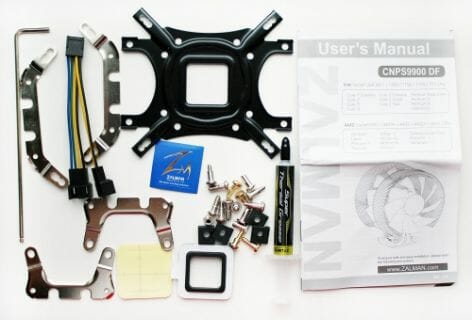
I have to specifically point out very high-quality Zalman ZM-STG2 thermal paste and a Y-splitter cable for connecting two fans to a single four-pin fan connector on the mainboard. As you can see, there is also an installation manual.
The cooler is made in Korea and comes with a two-year warranty. Its recommended price is $79.90, which is what it is currently retailing for.
Design and Functionality
We are very well familiar with Zalman cooling systems featuring a radial heatsink, we have been reviewing them since 2005, when the impressively efficient Zalman CNPS9500 LED came out. And today, seven years later, the new Zalman CNPS9900DF still has some of the familiar traits:
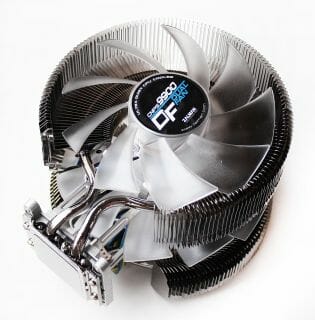
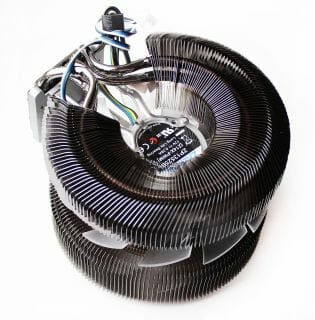
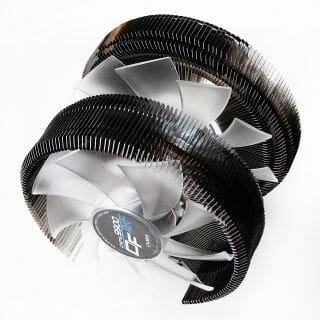
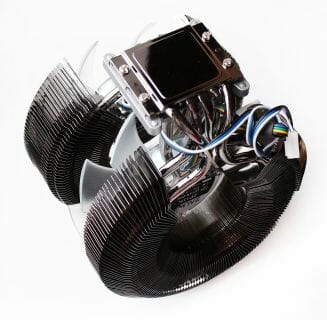
Although now the heatsink is built of two arrays, there are two fans and a different heatpipe layout. The cooler has also become larger and measured 154x140x100 mm. It weighs 850 grams.
The new Zalman CNPS9900DF is very similar to Zalman CNPS9900 MAX, but has an extra fan and a larger first heatsink array:
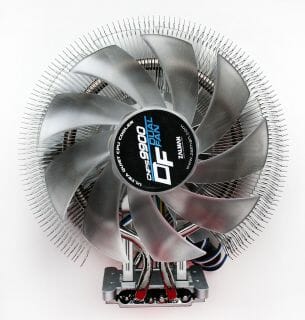
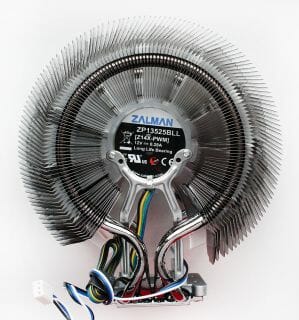
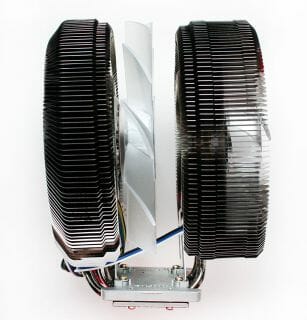
As a result, the total effective surface area of the Zalman CNPS9900DF compared with Zalman CNPS9900 MAX increased from 5,402 cm2 to 6,800 cm2. Although this number is still fairly low compared with what other contemporary super-coolers have to offer.
The heatsink fins soldered to the heatpipes at 1.0-2.5 mm distance from one another are made of solid copper and are nickel-plated, just like the heatpipes. A 135 mm fan sits in a recess in the first heatsink array. A second 120 mm fan is installed between the two heatsink arrays:
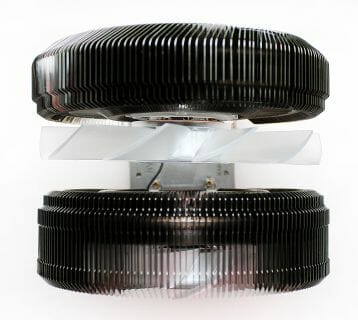
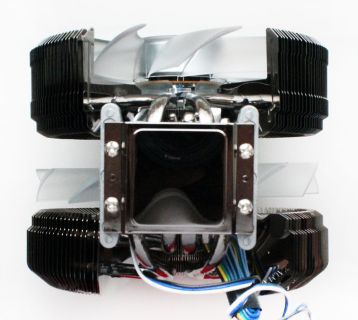
There are only three heatpipes and they come out of the cooler base in different directions. For some reason there is only one heatpipe piercing the larger heatsink array, while the smaller arrays has two heatpipes in it:
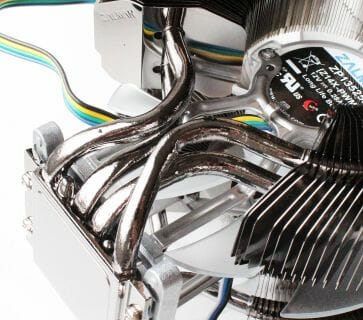
We don’t know what the reasoning behind this solution was, because it is more logical to have more heatpipes inside a larger heatsink array, because it should be dissipating more heat. Zalman engineers must be very confident in the efficiency of their composite heatpipes that is why they decided to implement this particular heatpipe layout and use so few heatpipes altogether:
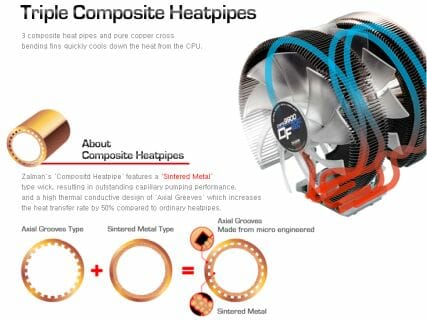
I would like to remind you that composite heatpipes, that are Zalman’s unique invention, can be 50% more efficient than regular heatpipes. Unfortunately, we haven’t yet been able to confirm this statement.
The heatpipes lie in special grooves in the cooler base and are soldered to the base:
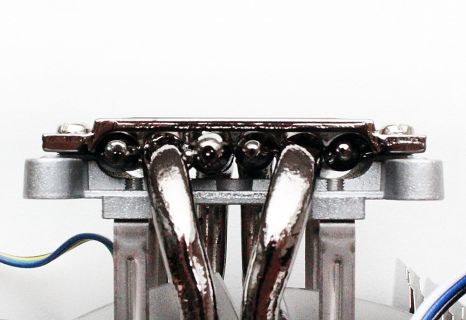
The finish quality of the cooler base contact surface is pure perfection:
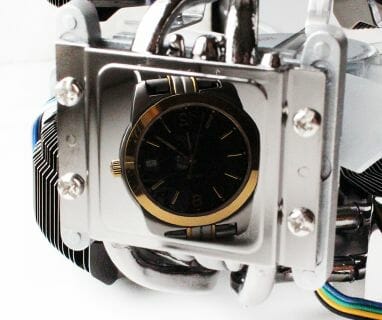
It is also impeccably smooth – the thermal paste imprints were complete and even for both cooler positions:
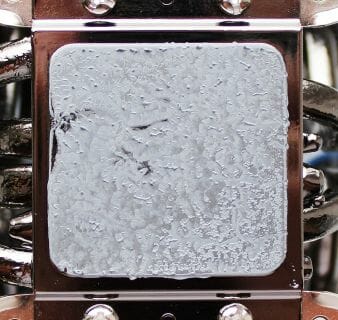
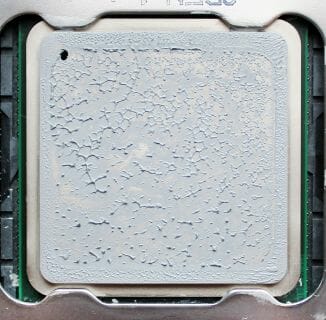
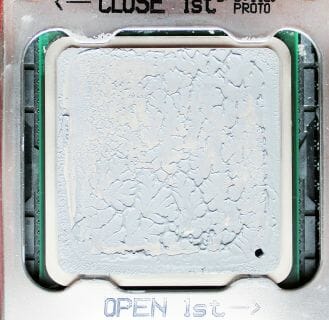
As for the fans, they deserve a separate mention. The fans have nine-blade impellers 120 and 135 mm in diameter respectively:
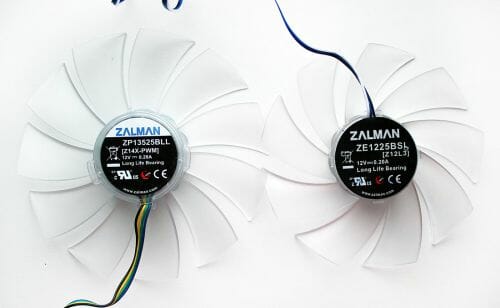
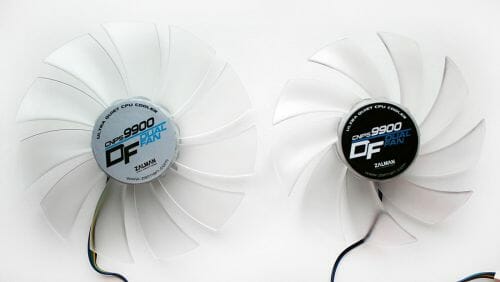
The rotation speed of the smaller central fan cannot be adjusted and is set at 1000 RPM. The larger fan can be controlled using PWM (Pulse-Width Modulation) method in 900-1400 RPM interval. Frankly speaking, we do not quite understand why they would mismatch the rotation speeds and fan diameters like that. The cooler noise is declared at 19-27 dBA and there is no mention of the MTBF for the enhanced slide bearings in the fan motors.
t out that both fans have blue LEDs, which makes the cooler look gorgeous in the dark of the night:
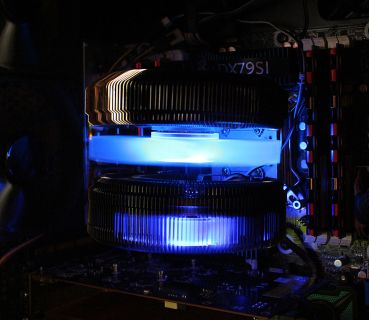
Compatibility and Installation
The new Zalman CNPS9900DF is a universal cooler in the full meaning of this word. It is fully compatible with all contemporary processors and platforms with no exceptions. All of them are listed on the official company web-site:
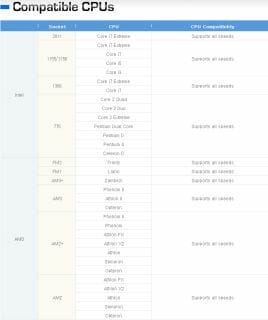
The installation procedure is the same for all platforms and starts by mounting the steel brackets to the base of the cooler:
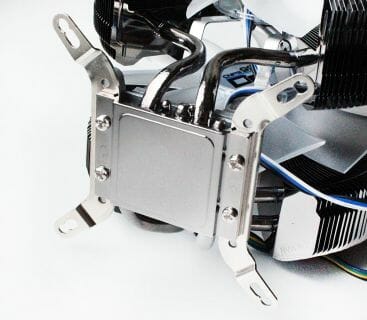
The photo shows the retention brackets for the Intel platform. If you are planning to install this cooler on the AMD platform, you will have to use a different set of straight brackets.
After that you apply a layer of thermal paste to the CPU, install the cooler on it and evenly tighten the four Allen screws (with hex-shaped sockets) with a special L-wrench:
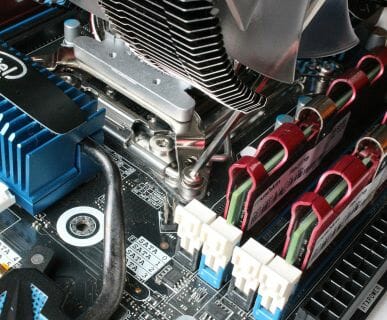
It may seem like a lot of trouble to actually complete this final stage. First, it is quite challenging to get into the retention bracket holes while tightening the screws. On top of that, the wrench inserted into the screw sockets at an angle doesn’t seem to go in and threatens to slide any second, while later you can barely get it out of the socket at all. Nevertheless, 10-15 minutes later when all screws are in place and tightened perfectly, the cooler sits securely on the mainboard and the processor.
As for the cooler compatibility with tall memory module heat-spreaders and other heatsinks around the processor socket, we can’t state definitively that Zalman CNPS9900DF won’t interfere with anything, because its lowest heatsink fins are only 30 mm above the mainboard surface:
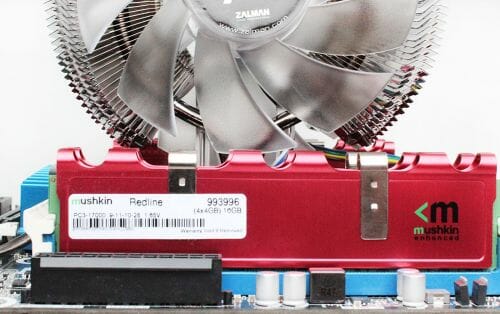
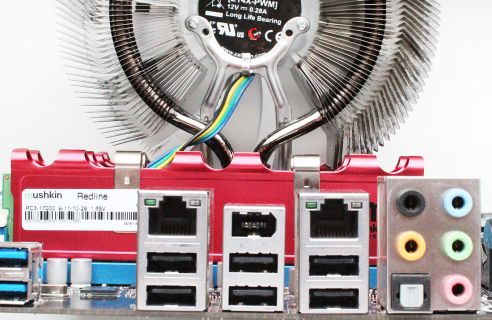
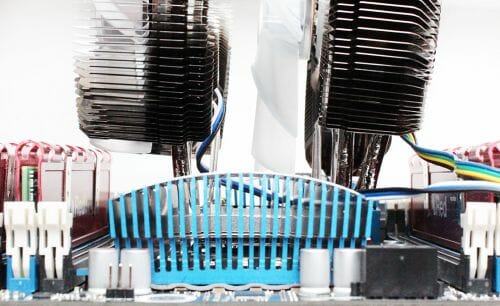
However, the bottom part of the heatsink is relatively compact that is why it could only potentially interfere with a memory module featuring a tall heatsink installed into the closest DIMM slot to the processor.
The manual recommends installing Zalman CNPS9900DF cooler in the following way:
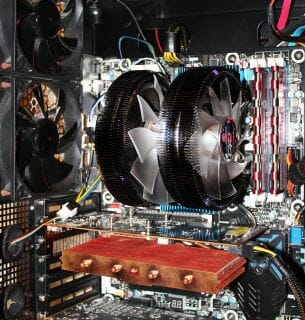
In addition, we also tested Zalman CNPS9900DF in an alternative orientation, i.e. rotated by 90 degrees:
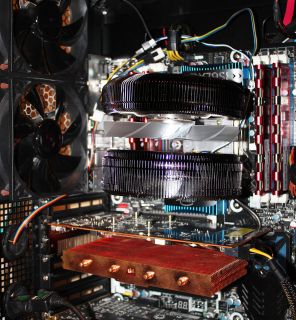
Remarkably, we didn’t register any efficiency differences between the two installations. And what particular level of efficiency we are talking about? Let’s find out next!
Testbed Configuration and Testing Methodology
We tested all coolers inside a closed system case with the following configuration:
- Mainboard: Intel Siler DX79SI (Intel X79 Express, LGA 2011, BIOS 0537 from 07/23/2012);
- CPU: Intel Core i7-3960X Extreme Edition, 3.3 GHz, 1.2 V, 6 x 256 KB L2, 15 MB L3 (Sandy Bridge-E, C1, 32 nm);
- Thermal interface: ARCTIC MX-4;
- Graphics card: AMD Radeon HD 7770 1 GB GDDR5 128 bit, 1000/4500 MHz (with a passive copper heatsink from the DeepCool V4000 VGA cooler);
- System memory: DDR3 4 x 4GB Mushkin Redline (Spec: 2133 MHz / 9-11-10-28 / 1.65 V);
- System drive: Crucial m4 256 GB SSD;
- Drive for programs and games: Western Digital VelociRaptor (300GB, SATA-II, 10000 RPM, 16MB cache, NCQ) inside Scythe Quiet Drive 3.5” HDD silencer and cooler;
- Backup drive: Samsung Ecogreen F4 HD204UI (SATA-II, 2 TB, 5400 RPM, 32 MB, NCQ);
- System case: Antec Twelve Hundred (front panel: three Noiseblocker NB-Multiframe S-Series MF12-S2 fans at 1020 RPM; back panel: two Noiseblocker NB-BlackSilent PRO PL-1 fans at 1020 RPM; top panel: standard 200 mm fan at 400 RPM);
- Control and monitoring panel: Zalman ZM-MFC3;
- Power supply: Seasonic SS-1000XP Active PFC F3 1000 W (with a default 120 mm fan).
For the primary tests and summary diagrams we overclocked our six-core processor with the clock generator frequency set at 125 MHz, the multiplier at 34x and “Load-Line Calibration” enabled to 4.25 GHz. The nominal processor Vcore was increased to 1.35 V in the mainboard BIOS. After that we tested the new cooler at even higher frequency and voltage settings. Turbo Boost was disabled during this test session, and Hyper-Threading technology was enabled to increase the heat dissipation. The memory voltage was at 1.65 V and its frequency was 2000 MHz with 9-11-10-28 timings. All other parameters available in the mainboard BIOS and related to CPU or memory overclocking remained unchanged.
All tests were performed under Windows 7 Ultimate x64 SP1 operating system. We used the following software during our test session:
- LinX AVX Edition version 0.6.4 – to load the processor (memory – 4500 MB, Problem Size – 24234, two 11-minute cycles);
- Real Temp GT version 3.70 – to monitor the processor core temperatures;
- Intel Extreme Tuning Utility version 3.1.201.5 – for monitoring and visual control of all system parameters during overclocking.
So, the complete screenshot during the test session looks as follows:
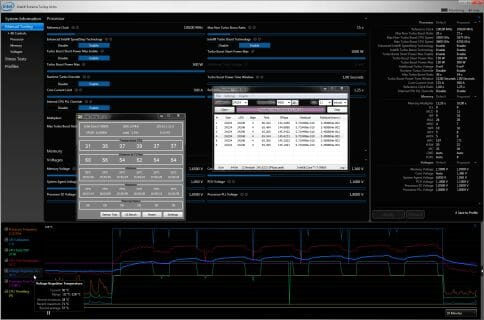
The CPU was loaded with two consecutive LinX AVX test runs with the settings as indicated above. The stabilization period for the CPU temperature between the two test cycles was about 8-10 minutes. We took the maximum temperature of the hottest CPU core for the results charts. Moreover, we will also provide a table with the temperature readings for all cores including their average values. The ambient temperature was checked next to the system case with an electronic thermometer with 0.1 °C precision that allows hourly monitoring of the temperature changes over the past 6 hours. The room temperature during our test session varied between 24.0-24.1°C.
The noise level of each cooler was measured between 1:00 and 3:00 AM in a closed room about 20 m2 big using CENTER-321 electronic noise meter. The noise level for each cooler was tested outside the system case when the only noise sources in the lab were the cooler and its fan. The noise meter was installed on a tripod and was always at a 150 mm distance from the cooler fan rotor. The tested cooling systems were placed at the edge of the desk on a sheet of polyurethane foam. The lowest noise reading our noise meter device can register is 29.8 dBA and the subjectively comfortable noise level in these testing conditions was around 36 dBA (do not mix it up with low noise level). The fan(s) rotation speed was adjusted in the entire supported range using our in-house controller by changing the voltage with 0.5 V increment.
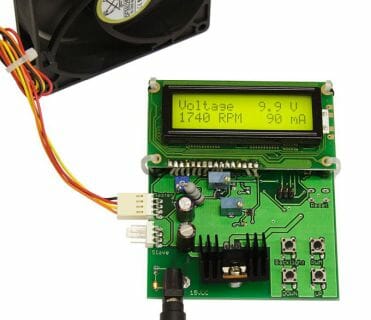
We are going to compare the cooling efficiency and noise levels of Zalman CNPS9900DF against those of Thermalright TRUE Spirit 140 equipped with one default TY-140 fan in two operational modes – at maximum fan speed and in quiet mode at 800 RPM:
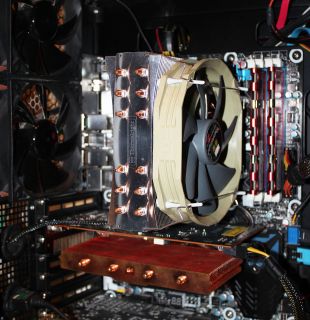
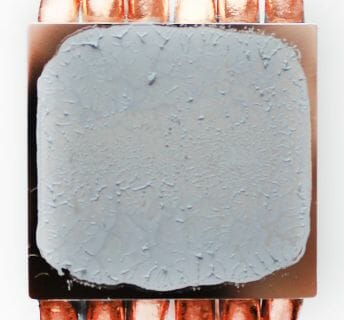
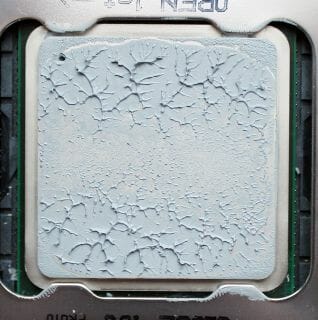
I would also like to add that the rotation speed of all fans was controlled using the same special controller I mentioned above with ±10 RPM precision.
Performance
Cooling Efficiency
The results of our cooling efficiency tests are given on the following diagram and in the following table:

As we can see, the new Zalman CNPS9900DF looks quite modest against the background of the Thermalright TRUE Spirit 140, which costs only half as much. At the maximum fan speed, TRU Spirit 140 is 3°C ahead in peak CPU temperature, but most importantly, Zalman CNPS9900DF wins only 1°C from the Thermalright cooler, even if the fan speed of the latter has been reduced to 810 RPM. While we gradually lower the fan speed for the Zalman CNPS9900DF fans in 200 RPM increments for the 135 mm fan and in 100 RPM increments for the 120 mm fan, the cooler efficiency lowers smoothly until we hit 1000/800 RPM. However, at the next increment the maximum CPU temperature increases by as much as 5°C, and at the next one – by another 6°C and reaches the critical maximum for the thermal throttling to kick in. In other words, the cooling efficiency of Zalman CNPS9900DF proves highly dependent on the fan speed in the 1000-800/800-650 RPM range, while at higher rotation speed its efficiency doesn’t increase dramatically.
I would like to remind you that we performed our cooling efficiency tests with the CPU overclocked to 4.25 GHz with 1.35 V Vcore instead of the traditional 4.375 GHz and 1.38 V Vcore. We were forced to deviate from our standard overclocking levels, because Zalman CNPS9900DF was unable to cope with this overclocking of our six-core processor even at the maximum fan speeds. We tried several times and checked different cooler positions on the CPU, but nothing helped:
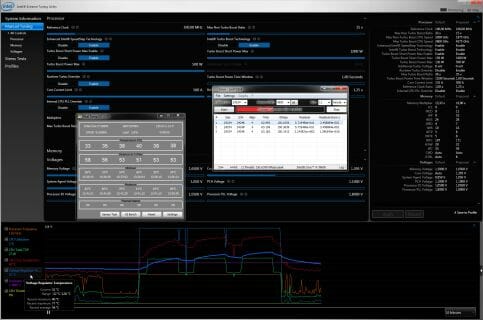
And since Zalman CNPS9900DF failed to pass the “minimum qualification requirements” for our summary diagrams, we will not include it there today. So, let’s move on to the noise tests now.
Acoustic Performance
We measured the noise level of our coolers throughout the entire speed range of their fans, as described in the chapter on testing methodology. Here are the results:
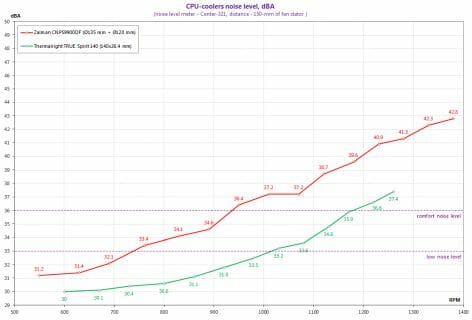
Most of the noise in Zalman CNPS9900DF comes from the 135 mm fan. The smaller fan is inaudible against its background. The cooler itself could be considered moderate in terms of noise levels, even though it is significantly behind Thermalright TRUE Spirit here, however, the rattling of the 135 mm fan motor becomes very distinct in the interval between 600 and 1050 RPM. The bearings and the airflow created by two fans do not make Zalman CNPS9900DF acoustically uncomfortable in any way, but the rattling of the motor starts getting on your nerves 3-4 minutes in. Therefore, we can’t consider Zalman CNPS9900DF acoustically comfortable or quiet, although the graph shows the readings at 940 and 740 RPM fall into acoustically comfortable and quiet range, respectively. Unfortunately, it doesn’t matter, because the rattling motor diminishes it all. It could be the peculiarity of our specific cooler sample, though.
Conclusion
Zalman CNPS9900DF turned out a real beauty, which would fit perfectly into the holiday concept and please your guests with unique shape and very nice blue lighting. Its indisputable advantages are full universality, reliable and informative packaging, and highly efficient thermal paste among the bundled accessories.
As for overclockers and quiet cooling fans, Zalman CNPS9900DF will be an attractive, yet expensive choice. Its efficiency is pretty modest and it most likely won’t let you unveil the entire overclocking potential of your processor. Moreover, very challenging installation procedure will hardly help this cooler win more users, especially beginners. Also, I have to bring up the rattling issue once again.
So, I have to admit that though Zalman CNPS9900DF will be a great addition to an open stand or modding system cases with clear side panels, it may not be able to cope with heavily overclocked processors especially in case of strict noise limitations. But, as always, it is up to you to decide, whether the advantages outweigh the concerns.